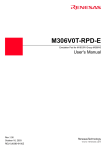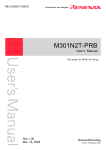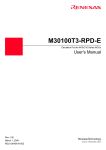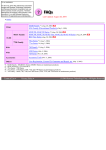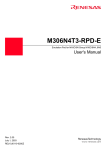Download Renesas Emulation Pod M3062PT3-RPD-E User`s manual
Transcript
M16C PC4701 Emulator Debugger V.1.03.00
Release Notes
This document describes the notes of this debugger, and please read before you start to use this
debugger.
And also, please refer to the “High-performance Embedded Workshop Release Notes” about the
notes of High-performance Embedded Workshop IDE.
Contents
1
Notes ..................................................................................................................................................... 2
1.1
Line Assembly ........................................................................................................................... 2
1.2
Event Setting............................................................................................................................. 2
1.3
Data Trace ................................................................................................................................. 2
1.4
Trace........................................................................................................................................... 2
1.5
RAM Monitor............................................................................................................................. 2
1.6
Memory ...................................................................................................................................... 2
1.7
Script.......................................................................................................................................... 2
1.8
Real-time OS debugging functions........................................................................................... 3
1.9
Macro recording function.......................................................................................................... 3
1.10
Test facility function ................................................................................................................. 3
1.11
Using cast operators for the member variable ........................................................................ 3
1.12
Download module dialog box .................................................................................................... 3
1.13
Real-time execution of the target program.............................................................................. 3
1.14
The option “Always treat variables of enumerator type with unknown size as 1 byte”....... 4
1.15
Debugging for assembler macros ............................................................................................. 4
1.16
Debugging for inline functions ................................................................................................. 4
1.17
Automatic target connection on changing the session............................................................ 4
1.18
Run program option .................................................................................................................. 4
1.19
Selection of the object format for download module ............................................................... 4
1.20
Notes on Debugging (M16C PC4701 Emulator Debugger) .................................................... 4
1.20.1 Variables assigned to registers ............................................................................................. 4
1.20.2 In the case of using PC4701M with IAR’s cross tools ......................................................... 4
1.20.3 About the self-check function ............................................................................................... 4
1.20.4 About LAN communication with emulators by Windows XP or Windows2000 ................ 5
1.20.5 Disassembly display in Trace window.................................................................................. 5
1.20.6 The option “Attempt to access memory even in WAIT/STOP mode”.................................. 5
2 System Requirements.......................................................................................................................... 6
2.1
M16C PC4701 Emulator Debugger ......................................................................................... 6
3 Version Report...................................................................................................................................... 8
3.1
M16C PC4701 Emulator Debugger V.1.03.00 ......................................................................... 8
3.1.1
Revisions to Restrictions....................................................................................................... 8
3.1.2
Functional Extensions and Modifications............................................................................ 8
3.2
M16C PC4701 Emulator Debugger V.1.02.00 ......................................................................... 8
3.2.1
Revisions to Restrictions....................................................................................................... 8
3.2.2
Functional Extensions and Modifications............................................................................ 9
3.3
M16C PC4701 Emulator Debugger V.1.01.00 ......................................................................... 9
3.3.1
Revisions to Restrictions....................................................................................................... 9
3.3.2
Functional Extensions........................................................................................................... 9
3.4
M16C PC4701 Emulator Debugger V.1.00.01 ......................................................................... 9
3.4.1
Revisions to Restrictions....................................................................................................... 9
3.4.2
Functional Extensions......................................................................................................... 10
REJ10J1594-0100 Rev.1.00 Jul.01.07
page 1 of 10
1
Notes
1.1
Line Assembly
Regardless of the Radix setting, the default for line assembly input is decimal. Specify H as the
radix for a hexadecimal input.
1.2
Event Setting
1.
TAB order in Set Event Status dialog box
Even when you press [TAB] key, the next input control may not be focused on the Set Event
Status dialog boxes opened from H/W Break, Time Measurement, and Trace Point.
2. In-place-edit mode on event list
On event list in H/W Break, Time measurement and Trace Point, High-performance Embedded
Workshop will not escape from in-place-edit mode even when you press the [ESC] key.
3. Event setting by BIT SYMBOL
When the specified address is odd numbers, the setting by BIT SYMBOL can not set the
correct condition. Use DATA ACCESS setting and specify the compared data with the data
mask. For details about how to set the conditions for odd number addresses, refer to the online
help.
4. Event detection for BIT SYMBOL
When the event is set to detect the access to specified bit, it will be detected even if the other
bit of the same address as the specified bit is accessed. This is because the access to the bit
from MCU is byte access.
1.3
1.
1.4
Data Trace
Split-bar behavior when double-clicking
If you double-click the split-bar, which divides view up and down, the horizontal scroll-bar,
vertical scroll-bar, and tabs in the upper view will vanish. Drag the split-bar to display them
again.
Trace
1.
Specifying function in SRC mode
In the SRC mode, when you specify a function to display it, if the current displayed source file
includes the function, the top of the source file will be displayed.
2. Saving of tracing result in text
When you save a tracing result in text with only “BUS” and “DATA” buttons ON, the vertical
position of some headers will shifts from the corresponding data. Check “Tab Separated
Format” and open it with spreadsheet applications to display them correctly.
3. Loading the trace image file
Trace window can not load the trace image file saved by PDxx debuggers. And also, trace
window can not load the trace image file saved by the different target from the current target.
1.5
1.
1.6
1.
1.7
RAM Monitor
Proportional Fonts
When a proportional font is selected, a part of the characters in the view may be hidden. Fixed
fonts are recommended.
Memory
8 bytes data operations
To set, fill, and copy 8 bytes data are not supported.
Script
1.
Result of interactive command
When you invoke an interactive command, for example, Assemble and setMemoryByte, the
running dialog box will appear and may hide the view of the results.
2. SCOPE Command
When you refer current scope name with SCOPE command after program execution, the scope
of the start-up module will be returned even if scope has been changed to the other.
REJ10J1594-0100 Rev.1.00 Jul.01.07
page 2 of 10
1.8
Real-time OS debugging functions
1.
When several labels are allocated to the entry address of the tasks or handlers, the task name
or the handler name displayed in the windows may be different from the actual function name.
2.
When you use the feature to issue system-calls by the script command (MR SYS), the target
program should be built with a specific option. For details, refer to the topic “Prepare the realtime OS debug” in the online help.
3.
When you use the task pause function, the following code should be inserted to the
configuration file of your target program. For details, refer to the user’s manual of the realtime OS.
// System Definition
system {
:
task_pause = yes; // Insert this line
};
4.
The task pause function uses the address match interrupt of the target MCU. When the target
program uses the address match interrupt, the task pause function can not be used.
5.
The script command “MR STK, BASE” assigns one coverage area so that the area includes the
top address of the system stack area. When you need to check the coverage of other areas,
don’t use the “MR STK, BASE” command and use the “CoVerage BASE” command to assign
coverage area instead. The system stack area and each task stack area will be displayed by
the script command “MR STK, SYS” and “MR STK, TASK”.
1.9
Macro recording function
The debug windows which support the macro recording function are memory, registers, IO, ASM
watch, and C watch. And also, the debug operations which support this are Reset CPU, Go, Reset Go,
Go To Cursor, Step In, Step Over, Step Out, Add/Delete break points, and Download the target
program.
1.10
Test facility function
The contents to be compared by the test facility functions are memory, registers, I/O, Output, stack
race, ASM watch, and C watch.
1.11
Using cast operators for the member variable
When you use cast operators for the member variable to refer to it as the pointer of the structure,
you would not refer to it correctly.
1.12
Download module dialog box
This debugger does not support the setting of "Offset", "Memory verify on download", and "Access
Size" in the download module setting dialog box. These are always treated as "Offset: 0", "Memory
verify: off", and "Access Size: 1".
1.13
Real-time execution of the target program
If the following operations are invoked while the target program is running, the real-time
execution capability will be lost.
! Dump memory
- update the display of Memory Window
- update the display of ASM Watch Window or C Watch Window
- update the display of Source Window (DIS or MIX mode)
- display the value of variables in Source Window
! Clear access history in RAM Monitor Window
! Change the ram monitor area in RAM Monitor Window
REJ10J1594-0100 Rev.1.00 Jul.01.07
page 3 of 10
!
!
!
Add or remove software break points
Change the status of hardware break points
Get the trace information forcibly or re-start recording the trace information in Trace Window
1.14
The option “Always treat variables of enumerator type with unknown size
as 1 byte”
The “Always treat variables of enumerator type with unknown size as 1 byte” option is effective
after downloading the program. When the option status is changed, target program should be
downloaded again.
And also, this option is effective for all variables of enumerator type in the program, even if the
compiling options are different for each file.
1.15
Debugging for assembler macros
When the break points are set at the assembler macro codes, the break points would be set at the
different address or not be displayed as the PC line.
1.16
Debugging for inline functions
When stepping the function including the call for a inline function, local variables would not be
able to be referred.
1.17
Automatic target connection on changing the session
When the target connection is not performed on changing the session, select the menu [Debug] ->
[Connect]. To perform automatic target connection, remove the check from the option “Do not
perform automatic target connection” in the Option tab on Debug Setting dialog box which is invoked
by the menu [Debug] -> [Debug Settings…].
1.18
Run program option
The “Run Program” dialog box enables to specify several temporary PC breakpoints, but this
debugger only supports one breakpoint which is listed first in the “Temporary PC breakpoints” list
box.
1.19
Selection of the object format for download module
When the specified file format in the debug setting dialog box is different from the format of the
object module file, downloading the file may cause a freeze of the debugger. Please select the correct
object format. And also, when selecting the object format for download module file, if there are two or
more object format, whose name includes the vender name another ones do not include it, prioritize
the file whose name includes vender name leading the object format name.
1.20
Notes on Debugging (M16C PC4701 Emulator Debugger)
1.20.1 Variables assigned to registers
When you build a target program, IAR EWM16C may generate the warning like following:
Warning [w23]: Cannot represent location of Register pair variable
'R1H:R1L'
In this case, you can not see the variable, which is assigned to R1 in the emulator software.
IAR will fix it by upgrading XLINK in near future. Please ask IAR about it for more details.
1.20.2 In the case of using PC4701M with IAR’s cross tools
When you have all the following conditions at once, the IAR’s cross tools may not work correctly.
- Using the PC4701M in ECP mode of LPT connection
- The M16C PC4701 emulator software running
1.20.3 About the self-check function
In using the self-check function, if you connect the PC4701 emulator with PC via LAN interface,
REJ10J1594-0100 Rev.1.00 Jul.01.07
page 4 of 10
the self-check may fail to diagnose the emulator. When you use the self-check function, please use
another communication interface except LAN interface.
1.20.4 About LAN communication with emulators by Windows XP or Windows2000
It is necessary for LAN communication with emulators by Windows XP or Windows 2000 to set the
following registry.
1. When using Windows XP or Windows 2000
Key
HKEY_LOCAL_MACHINE\SYSTEM\CurrentControlSet\Services\Tcpip\
Parameters\SackOpts
Value
0 (REG_DWORD)
You can set this registry by executing the registry setup program, "Sack.exe". And you can clear
the registry with running the program "UnSack.exe".
- Sack.exe", the program setting the registry.
- Unsack.exe", the program clearing the registry.
The above programs are installed under the directory "\Utility" in the directory where the
emulator software is installed.
(Ex. C:\ Renesas\HEW\Tools\Renesas\DebugComp\Platform\PDTarget)
When using Windows XP/2000, make sure Sack.exe and UnSack.exe are executed by a user who
has Administrator rights. Users without Administrator rights cannot set the registry.
Supplementary:
Windows XP/2000 TCP supports "Selective Acknowledgments (SACK)" as documented in RFC
2018. SACK gives higher performance in the network which have high bandwidth and long roundtrip delays like satellite channels. SACK support is enabled by default in Windows XP/2000. It is
necessary for LAN communication with emulators by Windows XP/2000 to disable SACK support.
Setting the above registry can disable SACK support.
Note that when you use the network which have high bandwidth and long round-trip delays like
satellite channels, the performance with SACK support disabled is lower than with enabled.
1.20.5 Disassembly display in Trace window
The disassembled instructions may not be displayed correctly in the case blow:
- The operand fetch results are not stored in the trace memory because of the lack of the trace
memory.
- Address match interrupt occurred just after the opecode fetch.
1.20.6 The option “Attempt to access memory even in WAIT/STOP mode”
The option “Attempt to access memory even in WAIT/STOP mode” has been added since the
emulator debugger V.1.03. If the option is OFF, the debugger checks whether the status of the
connected MCU is HALT. And if the MCU is in HALT status, debugger does not access memory. This
behavior will improve the freeze for several seconds because of the memory access to the MCU in
HALT status. Instead, it will cause a little overhead to check the status in each memory accesses. Set
the check to this option, if the operations slow because of the overhead.
REJ10J1594-0100 Rev.1.00 Jul.01.07
page 5 of 10
2
System Requirements
2.1
M16C PC4701 Emulator Debugger
Target host PC
PC
OS
Memory
HDD
Display Resolution
Emulator
PC4701U
IBM PC/AT compatible with Pentium III 600MHz or higher
Windows XP
Windows 2000
128MB or more (and in addition, ten or more times as much size as
the load module file).
Hard disk available capacity for installation: 100MB or more.
Prepare an area at least double the memory capacity (four-times or
more recommended) as the swap area.
1024 x 768 or higher recommended
PC4701M
Emulation Pod for M16C/60 Series
M30600T-RPD-E
M30600T-RPD-E remodeled for M16C/61
M30600T-RPD-E remodeled for M16C/62
M30610T-RPD-E
M30610T-RPD-E remodeled for M16C/62
M30620T-RPD-E
M30620TB-RPD-E
M30620T2-RPD-E
M30620TL-RPD-E
M306H0T-RPD-E
M306H1T-RPD-E
M306H2T-RPD-E
M306H3T3-RPD-E
M306H5T3-RPD-E
M306K5T-RPD-E
M306N0TB-RPD-E
M306N0T2-RPD-E
M306NAT2-RPD-E
M306NKT3-RPD-E
M306V0T-RPD-E
M306V2T-RPD-E
M306V3T-RPD-E
M306V7T-RPD-E
M3062PT3-RPD-E
M3062NT3-RPD-E
M306N4T3-RPD-E
REJ10J1594-0100 Rev.1.00 Jul.01.07
page 6 of 10
PC4701HS
MCU file
M30600.MCU
M3060061.MCU
M3060062.MCU
M30610.MCU
M3061062.MCU
M30620T.MCU
M30620TB.MCU
M30620T2.MCU
M30620TL.MCU
M306H0.MCU
M306H1.MCU
M306H2.MCU
M306H3T3.MCU
M306H5T3.MCU
M306K5.MCU
M306N0TB.MCU
M306N0T2.MCU
M306NA.MCU
M306NKT3.MCU
M306V0.MCU
M306V2.MCU
M306V3.MCU
M306V7.MCU
M3062PT3.MCU
M3062NT3.MCU
M306N4T3.MCU
PC4700H
Emulation Pod for M16C/20 Series
M30200T-RPD-E + M30201T-PRB
M30200T-RPD-E + M30218T-PRB
M30200T-RPD-E + M30220T-PRB
(M30220TF-PRB)
M30240T-RPD-E
M30245T-RPD-E
M30200T-RPD-E + M302N2T-PRB
M30245T3-RPD-E
M30240.MCU
M30245.MCU
M302N2.MCU
M30245T3.MCU
Emulation Pod for M16C/10 Series
M30100T-RPD-E + M30100T-PRB
M30100T3-RPD-E + M30100T-PRB
M30100T-RPD-E + M301N2T-PRB
M30100T3-RPD-E + M301N2T-PRB
MCU file
M30100.MCU
M30100T3.MCU
M301N2.MCU
M301N2T3.MCU
REJ10J1594-0100 Rev.1.00 Jul.01.07
page 7 of 10
MCU file
M30201.MCU
M30218.MCU
M30220.MCU
3
Version Report
This section describes the specification of the changed software.
3.1
M16C PC4701 Emulator Debugger V.1.03.00
In this version, the following specifications were changed from the previous version M16C PC4701
Emulator Debugger V.1.02.00.
This version supports all of the function extensions and the revisions to the restrictions in the
High-performance Embedded Workshop V.4.02.00 and V.4.03.00. For more details, please refer to the
RENESAS TOOL NEWS “061216/tn2” issued on December 16, 2006 and “070701/tn1” issued on
September 1st, 2007.
3.1.1
Revisions to Restrictions
1. A limitation has been corrected: if the On Demand check box is checked in the Debugging
Information tab of the Init dialog box, which appears when you invoke your debugger, target
programs may not be loaded successfully on MCUs and not run properly. (For more details,
refer to the RENESAS TOOL NEWS “070416/tn8” issued on April 16, 2007).
2. A limitation has been corrected: If the size of the variable to be referred by the quick watch
feature is larger than 256 bytes, High-performance Embedded Workshop would crash. (For
more details, refer to the RENESAS TOOL NEWS “070601/tn5” issued on June 1st, 2007).
3.1.2
Functional Extensions and Modifications
1. Displaying source files information automatically in the Workspace Window.
When a download module file is downloaded, the High-performance Embedded Workshop
obtains source files information contained in the download module file through its debug
information, and displays it under "download module" node in the Projects tab on the
Workspace Window. Note that this function is available only for debugging the debug-only
projects.
2. Supports C watch window included in High-performance Embedded Workshop V.4.03. The
feature Changing scope of the variable and suppression leading zero are supported.
3. The option to specify the size (1byte or 2byte) of enumerator type is added.
4. Supports “Disconnect target” feature.
5. When the instruction is modified by the line assemble feature, if the old instruction length is
longer than the new instruction length, NOP instructions are inserted automatically so as to
suit the old instruction length.
6. The instruction format specifier is displayed for each instruction in disassembly. And also, can
be switched not to display.
7. Supports to substitute the bit field member variable.
8. The default value of “Reset CPU after download module” is changed to be checked.
9. The option not to access memory while CPU is wait/stop mode is added.
3.2
M16C PC4701 Emulator Debugger V.1.02.00
In this version, the following specifications were changed from the previous version M16C PC4701
Emulator Debugger V.1.01.00.
This version supports all of the function extensions and the revisions to the restrictions in the
High-performance Embedded Workshop V.4.01.00 and V.4.01.01. For more details, please refer to
RENESAS TOOL NEWS “060701/tn1” issued on July 1, 2006 and “060801/tn1” issued on August 1,
2006.
3.2.1
1.
Revisions to Restrictions
A limitation has been corrected: The structure member variables, union member variables, or
class member variables whose name begins with a letter of ‘e’ or ‘E’ immediately followed by a
numeral, are not referenced.
For more details, refer to the RENESAS TOOL NEWS RSO-M3T-PD32RM-060116D issued on
January 16, 2006.
REJ10J1594-0100 Rev.1.00 Jul.01.07
page 8 of 10
3.2.2
Functional Extensions and Modifications
1.
The real-time OS, M3T-MR30/4 which is compliant to μITRON 4.0 specifications, has been
supported.
2. The ELF/DWARF2 format files generated using KPIT GNUM16C have been supported.
3. These commands, which can be invoked in Command Line, have been supported:
breakpoint, breakpoint_disable, breakpoint_display, breakpoint_clear
register_display, register_set
disassemble, assemble
3.3
M16C PC4701 Emulator Debugger V.1.01.00
In this version, the following specifications were changed from the previous version M16C PC4701
Emulator Debugger V.1.00.01.
This version supports all of the function extensions and the revisions to the restrictions in the
High-performance Embedded Workshop V.4.00.02. For more details, please refer to RENESAS TOOL
NEWS RSO-HEW_1-050701D issued on July 1, 2005.
3.3.1
1.
2.
3.3.2
1.
Revisions to Restrictions
A limitation has been corrected: To keep quickly pushing the step button on the toolbar
switches the source mode of the source window into the disassembly mode.
Trace window may not read trace memory image files which was saved in the Trace window.
Functional Extensions
The following windows for the real-time OS debugging are added to this version.
(a)
(b)
(c)
(d)
(e)
(f)
3.4
MR Window
MR Trace Window
MR Analyze Window
MR Task Pause Window
Task Trace Window
Task Analyze Window
M16C PC4701 Emulator Debugger V.1.00.01
In this version, the following specifications were changed from the previous version M16C PC4701
Emulator Debugger V.1.00.00.
3.4.1
Revisions to Restrictions
1.
A limitation has been corrected: The automatic backup function of workspaces does not
operate properly.
For more details, please refer to RENESAS TOOL NEWS RSO-HEW_1-050216D issued on
February 16, 2005.
2.
A limitation has been corrected: When connecting with emulator PC7501 or compact emulator
in a debugging session of them, High-performance Embedded Workshop might load break
points using address match interrupt that are deleted before.
3.
A limitation has been corrected: When a setting of RAM monitoring area is changed with
RAM Monitor Area Setting window, the setting displayed on-screen may not match with the
actual ones, resulting in improper operation.
For more details, refer to RENESAS TOOL NEWS RSO-M3T-PD308MF-050216D issued on
February 16, 2005.
4.
A limitation has been corrected: If any of the following operations is performed with the C
Watch window being undocked, the High-performance Embedded Workshop abnormally shut
down.
(a) Switching between sessions
(b) Closing a workspace
REJ10J1594-0100 Rev.1.00 Jul.01.07
page 9 of 10
(c) Terminating an application program
For more details, please refer to RENESAS TOOL NEWS RSO-HEW_2-050301D issued on
March 1, 2005.
5.
A limitation has been corrected: C watch window may not load correct variable names which
are registered in the watch tab.
This problem occurs if a variable name is entered in any of the following ways:
(a) An element of an array is specified using [ ] operator.
Example: a[0]
(b) A member of a structure or union is specified using . operator.
Example: str.a
(c) The destination of a pointer is pointed to using -> operator.
Example: pstr->a
(d) An Address or indirection operator (& or *) is used.
Example: &a or *a
For more details, please refer to RENESAS TOOL NEWS RSO-HEW_3-050301D issued on
March 1, 2005.
6.
3.4.2
1.
2.
A limitation has been corrected: The drag and drop operation in memory window may cause
the general protection failure.
Functional Extensions
Script window is modified to be able to change the display font.
The menu to open the online help for the emulator is added.
REJ10J1594-0100 Rev.1.00 Jul.01.07
page 10 of 10














